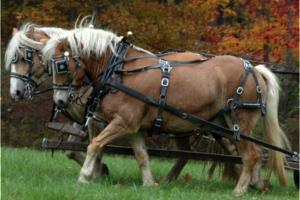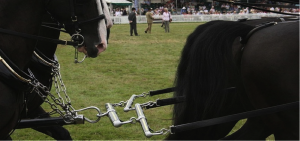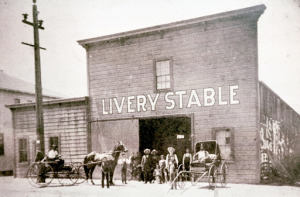 The prominent features of this exhibit are the two buggies and the livery stable wall.
The prominent features of this exhibit are the two buggies and the livery stable wall.
Auto-Seat Top Buggy: Commonly called a doctor’s buggy, this vehicle is probably an Auto-Seat Top Buggy, distinctive and popular because of its lightness and economy, c. 1890. The seat style is similar to that used in early automobiles. This one was rescued from a small Patterson barn. In 1994, it was refinished to its present condition.
Whitechapel Buggy: Stored in the Chadbourne Carriage House and used twice since 1916, this carriage resembles a Whitechapel Buggy and Stick Seat, c. 1885. The seat style was named for the “sticks” used in the sides.
The strong box is from Stockton or Sacramento and is said to have been used by John C. Fremont.
The Livery Stable wall includes an assortment of tack for horses and carriages: doubletree, singletree, hame, horseshoe, curry brush, straps, and halters. (A hame is one of two curved supports attached to the collar of a draft horse to which the traces are fastened.)
Other collections:
- Hand-made items collection: a square nail collection and a spike.
- A stepladder from the Berge estate donated by Carmelita Freitas and a sack of cornhusks are items that could also be in a livery stable.
- On the wall above the Livery Stable display are various farm implements: 2 sickles, a bow saw, a saw with large teeth, a two man saw with large teeth, and an unknown wooden implement with a metal end that looks like a saw.
- On the other side of the display is a pair of chaps used by historian Philip Holmes in his home state of Washington before he became a teacher and administrator. Also on the wall are a baling hook, two large hooks, a fire poker, a bridle and horseshoes.
- The sidesaddle was used by Jane Mallon Stevenson to ride to church on Sundays to Mission San Jose from the Stevenson ranch, Centerville (near Brookvale today).
- The porcelain batteries (wet-cell) are made by Gladstone-LaLand c. 1910. The containers were filled with a caustic soda solution. The zinc and copper plates inside react with the solution to create electricity. The batteries are from the former Davis estate in Mission San Jose.
- Grinder, used to sharpen tools, etc.
- The open trunk was used by the Walter’s family. See information about the George Walters in Reflections: The Educational Heritage of Fremont.
- One black steamer trunk, unknown origin
- Poster: Moving People and Goods – Shows the various types of transportation beside horses, used throughout the area’s history: boats, train, automobile, truck, and airplane.
- The 1914 red porcelain license plate is the first series issued in California. It was manufactured in Pennsylvania. This plate was from the Rose barn in Niles.
- The wooden farm wagon bumper was made to be portable to put on farm vehicles when the farmer had to drive on the road. It includes a license plate from 1930 and a coal oil lamp that was the red taillight.
The Livery Stable and Blacksmith Shop
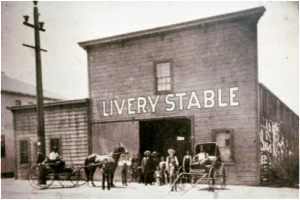 Horse travel was the most common method of transportation in the 1800s. Just as most towns today have a convenience store where travelers refuel their vehicles, the early towns of Washington Township had livery stables where travelers “refueled” their horses.
Horse travel was the most common method of transportation in the 1800s. Just as most towns today have a convenience store where travelers refuel their vehicles, the early towns of Washington Township had livery stables where travelers “refueled” their horses.
Visitors could leave their horses at the livery stable while staying in town. It was a hotel for horses where the animals were fed, watered and provided with a stall. At the livery stable people who did not own a horse could rent one. Buggies and wagons could also be rented.
Men often gathered at the livery stable to talk. It was a place where they relaxed, told stories or exchanged information and ideas. Below: the Livery Stable in Niles.
The Blacksmith
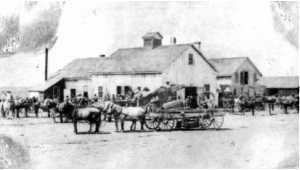 A person of great skill worked in the blacksmith shop. Blacksmiths had studied metal craft and could shape iron into tools, horseshoes and wagon-wheel rims. The ring of the blacksmith’s hammer striking the anvil and the clop, clop of horses’ shod hoofs were part of the familiar everyday sounds of a town. Below: Timothy Rix Blacksmith shop 1868, Irvington.
A person of great skill worked in the blacksmith shop. Blacksmiths had studied metal craft and could shape iron into tools, horseshoes and wagon-wheel rims. The ring of the blacksmith’s hammer striking the anvil and the clop, clop of horses’ shod hoofs were part of the familiar everyday sounds of a town. Below: Timothy Rix Blacksmith shop 1868, Irvington.
Livery Stables to Garages and Service Stations
The livery stable and the blacksmith shop were two businesses found in the small towns of Washington Township in the early 1900s. Both provided services that people needed. Most people valued the skill and hard work required of the owners. By the mid-1900s there was no longer a need for livery stables and blacksmiths. Jobs that were once essential to a community became unnecessary as automobiles replaced horses. Garages and service stations replaced livery stables.
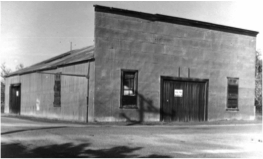
Chadbourn Garage
Irvington
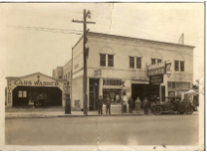
American Garage
Niles (1920-1930)
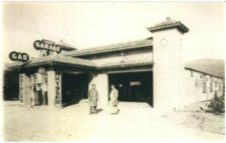
Liberty Garage
Warm Springs
Horse Harness Diagrams
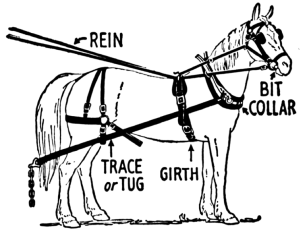
What is the difference between a singletree, a doubletree, and a neck yoke?
The difference between the neck yoke and singletree is much the difference between their mouth and what you find under their tail!
A neck yoke is what two horses use to hold the end of the wagon pole between them, at their chests. The neck yoke is usually held suspended from the horses’ collars or hames. It is used for steering the wagon tongue and preventing the wagon from overtaking the horses when slowing or when on a downhill grade.
A single tree goes behind a single horse and hooks to the harness and then to the load. It often has a hook on each end to fasten to the trace chains and in the center of the single tree there is often a small ring for fastening a clevis or chain, etc.
A singletree can be used by itself with the traces attached to the ends of the singletree and the load being drawn by the center of the singletree. Or, a singletree can be used in multiple arrangements when hooking multiple horses to a single load such as a wagon or a plow. In that instance, two or more singletrees will be attached to additional beams of wood so that the pull of each horse will be evenly distributed and balanced against his teammates to draw a single load. This arrangement of singletrees and beams is called an “evener”.
Two singletrees with one evening beam is called a “doubletree”
A neck yoke and a singletree look very similar.
